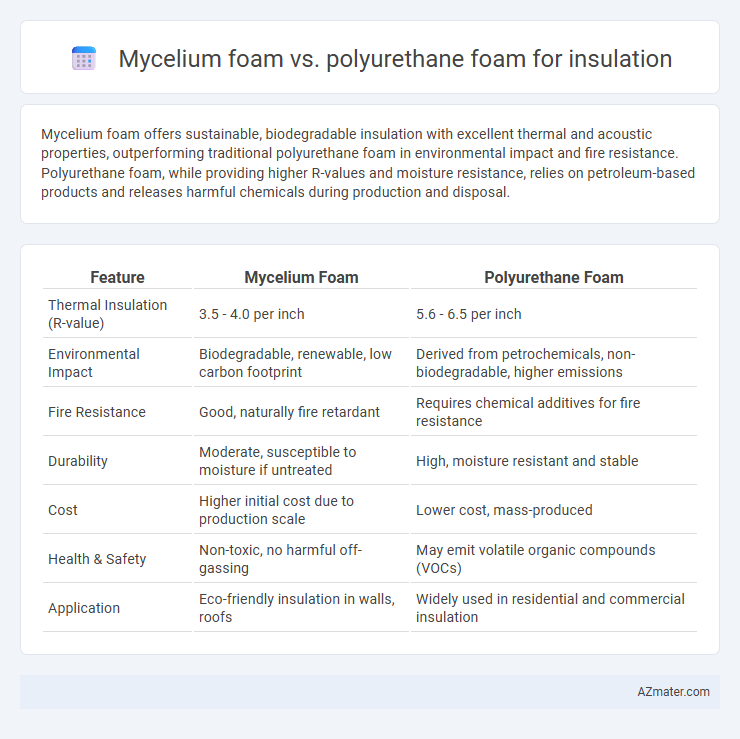Mycelium foam offers sustainable, biodegradable insulation with excellent thermal and acoustic properties, outperforming traditional polyurethane foam in environmental impact and fire resistance. Polyurethane foam, while providing higher R-values and moisture resistance, relies on petroleum-based products and releases harmful chemicals during production and disposal.
Table of Comparison
| Feature | Mycelium Foam | Polyurethane Foam |
|---|---|---|
| Thermal Insulation (R-value) | 3.5 - 4.0 per inch | 5.6 - 6.5 per inch |
| Environmental Impact | Biodegradable, renewable, low carbon footprint | Derived from petrochemicals, non-biodegradable, higher emissions |
| Fire Resistance | Good, naturally fire retardant | Requires chemical additives for fire resistance |
| Durability | Moderate, susceptible to moisture if untreated | High, moisture resistant and stable |
| Cost | Higher initial cost due to production scale | Lower cost, mass-produced |
| Health & Safety | Non-toxic, no harmful off-gassing | May emit volatile organic compounds (VOCs) |
| Application | Eco-friendly insulation in walls, roofs | Widely used in residential and commercial insulation |
Introduction: Sustainable Insulation Solutions
Mycelium foam offers a biodegradable alternative to traditional polyurethane foam, derived from fungal root networks that provide natural thermal and acoustic insulation. Polyurethane foam, a petroleum-based product, excels in durability and moisture resistance but poses environmental concerns due to its non-biodegradable nature and chemical emissions. Choosing mycelium foam supports sustainability goals by reducing carbon footprint and promoting eco-friendly building materials without sacrificing insulation performance.
What is Mycelium Foam?
Mycelium foam is a sustainable insulation material derived from the root structure of fungi, which naturally binds agricultural waste into a dense, fire-resistant, and biodegradable foam. Unlike polyurethane foam, Mycelium foam offers superior eco-friendly properties with low embodied energy and excellent thermal insulation performance. Its natural composition promotes indoor air quality by being non-toxic and resistant to mold, making it a healthier alternative for building insulation.
What is Polyurethane Foam?
Polyurethane foam is a versatile insulation material composed of organic polymers formed through the reaction of polyols and isocyanates, offering high thermal resistance and excellent air sealing properties. It is widely used in residential and commercial buildings due to its lightweight structure, durability, and moisture resistance. Compared to mycelium foam, polyurethane foam typically provides superior R-values, contributing to enhanced energy efficiency in insulation applications.
Comparative Thermal Insulation Performance
Mycelium foam offers a thermal conductivity ranging from 0.04 to 0.06 W/m*K, making it a competitive natural alternative to polyurethane foam, which typically ranges from 0.02 to 0.03 W/m*K. Despite polyurethane foam providing superior thermal insulation performance due to its lower thermal conductivity, mycelium foam's eco-friendly properties and biodegradability make it a sustainable choice for green building insulation. Performance variations in both materials depend on density, formulation, and application methods, influencing heat transfer resistance and overall energy efficiency in buildings.
Environmental Impact and Sustainability
Mycelium foam offers significant environmental benefits over polyurethane foam due to its biodegradable properties and renewable source, as it is grown from agricultural waste and fungi. Polyurethane foam, derived from petroleum-based chemicals, contributes to greenhouse gas emissions and is challenging to recycle, leading to long-term landfill waste. Mycelium foam's carbon-neutral lifecycle and low energy production process make it a more sustainable insulation option for reducing a building's environmental footprint.
Fire Resistance and Safety
Mycelium foam offers superior fire resistance compared to polyurethane foam due to its natural flame-retardant properties and lack of toxic chemical additives, reducing the risk of hazardous smoke during combustion. Polyurethane foam, while providing excellent thermal insulation, tends to be highly flammable and emits harmful gases when ignited, posing significant safety concerns. The sustainable, non-toxic nature of mycelium foam makes it a safer alternative in building insulation where fire safety is a critical consideration.
Durability and Longevity
Mycelium foam demonstrates superior biodegradability and resistance to moisture compared to polyurethane foam, which often faces degradation from UV exposure and chemical breakdown over time. Polyurethane foam typically offers longer-lasting thermal insulation performance but can lose effectiveness through physical deterioration and off-gassing. Selecting between mycelium and polyurethane foams depends on balancing sustainability goals with the required durability for specific insulation applications.
Ease of Installation
Mycelium foam offers ease of installation due to its lightweight, moldable nature, allowing it to fit irregular spaces without specialized tools. Polyurethane foam requires professional equipment for spray application, making it less accessible for DIY projects but providing seamless coverage and excellent adhesion. The choice between the two depends on project scale, desired insulation performance, and installation preferences.
Cost Analysis
Mycelium foam insulation typically costs more upfront compared to traditional polyurethane foam due to limited large-scale production and raw material sourcing challenges. However, mycelium's renewable nature and biodegradability can reduce long-term environmental remediation costs often associated with polyurethane's petrochemical base. Lifecycle cost analysis reveals that while polyurethane offers lower initial expenses and superior insulation R-values, mycelium foam may present cost savings through sustainability incentives and disposal advantages.
Future Prospects in Insulation Technology
Mycelium foam, derived from fungal mycelium, offers a sustainable and biodegradable alternative to traditional polyurethane foam in insulation applications. Its natural thermal resistance and fire-retardant properties present significant potential for eco-friendly building materials as regulatory standards push for greener construction technologies. Advances in bioengineering and scalable production methods are expected to enhance mycelium foam's performance and cost-efficiency, positioning it as a promising future insulator.

Infographic: Mycelium foam vs Polyurethane foam for Insulation
 azmater.com
azmater.com